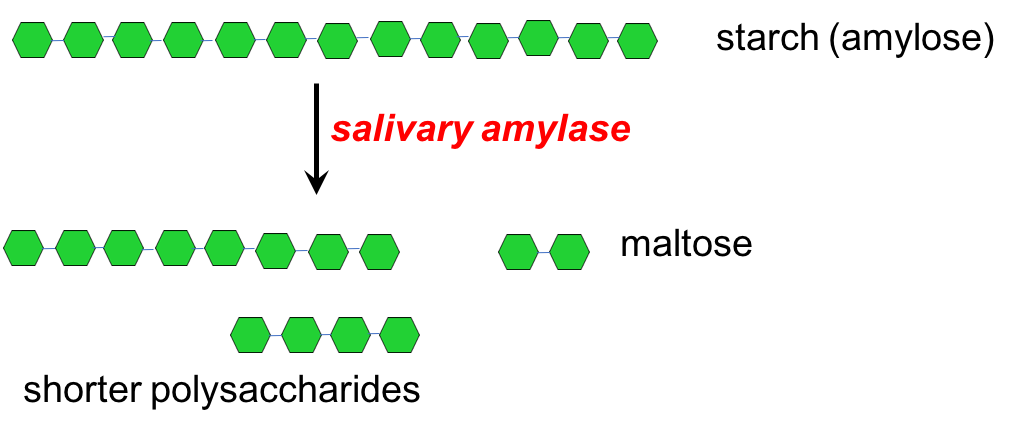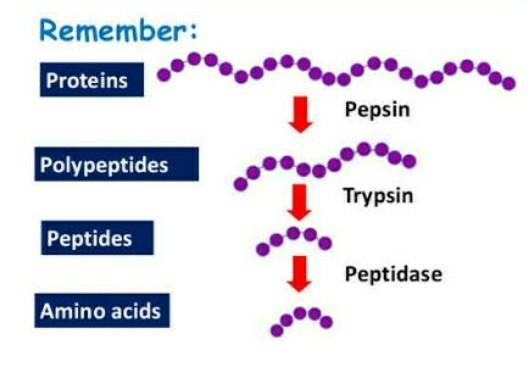Table of Contents
What are the Function of Digestive Enzymes ?
Digestion is the process in which complex and large components of food are broken down into their respective simpler and smaller forms with the help of various types of Digestive Enzymes.Digestive enzymes help in digesting complex food materials into simpler molecules for easy absorption by the body.
5 Important Functions of Digestive Enzymes are as Follows
Carbohydrate Digestion
Enzyme – Salivary Amylase
Location- Secreted in the mouth by the salivary glands
Function
- Digestive enzymes, such as salivary amylase, break down complex carbohydrates ( starches ) into simpler sugars such as glucose.
- Salivary amylase is secreted by the salivary glands in the mouth and initiates the digestion of starch by breaking it down into smaller sugar molecules.

Protein Digestion
Enzymes – Pepsin, trypsin, chymotrypsin and peptidase
Locations
- Pepsin – Stomach
- Trypsin and Chymotrypsin- Small intestine (produced by pancreas)
- Peptidase- Stomach, small intestine and pancreas
Function
- Digestive enzymes are responsible for breaking down proteins into smaller peptides and amino acids.
- Different enzymes are involved in protein digestion at different stages of the digestive process.
- Pepsin, for example, which is produced in the stomach, breaks down the proteins in the ingested food.
- In the small intestine, trypsin and chymotrypsin, produced by the pancreas, further break down proteins into smaller peptides and amino acids.
- Peptidase is another important enzyme involved in protein digestion and is produced in the stomach, small intestine and pancreas.
- Its main function is to hydrolyse protein substrates and break them down into amino acids.

Fat Digestion
Enzyme – Lipase
Locations- Pancreas, mouth and stomach
Function
- Digestive enzymes known as lipases break down dietary fats (triglycerides) into smaller molecules called fatty acids and glycerol.
- Lipase is produced in the pancreas, mouth and stomach and helps digest dietary fats.

Nucleic Acid Digestion
Enzyme- Nucleases
Location- Small intestine
Function
- Nucleases are enzymes responsible for breaking down DNA and RNA into nucleotides.
- These nucleotides can be absorbed by the body and used for various functions.
Enhancement of Absorption
Enzyme- Lactase (example)
Location- Small intestine
Function
- Some digestive enzymes, such as lactase, play a role in the digestion of lactose, the sugar found in milk.
- Lactase breaks down lactose into simpler sugars (glucose and galactose), allowing them to be absorbed.
- A deficiency of these enzymes can lead to lactose intolerance, as the undigested lactose can cause digestive discomfort.
- The digestive enzymes work together to break down food into smaller molecules that can be absorbed by the small intestine.
- The small intestine is lined with villi, which are tiny finger-like projections that increase the surface area of the intestine.
- This allows nutrients to be absorbed more efficiently.
Once the food is digested, the nutrients are absorbed into the bloodstream and transported to the cells in the body. The cells use these nutrients for energy, growth and repair.Digestive enzymes are essential for good health. Without them, we would not be able to digest food and absorb nutrients. This could lead to malnutrition and other health problems.
Also Check – List of Digestive enzymes, their sources, site of action, reactant and product and optimal ph
| Digestive Enzyme | Source Organ | Site of Action | Reactant and Product | Optimal pH |
| Salivary Amylase | Salivary Glands | Mouth | starch + water ⇒ maltose | Neutral |
| Pepsin | Stomach | Stomach | protein + water ⇒ peptides | Acidic |
| Pancreatic Amylase | Pancreas | Duodenum | starch + water ⇒ maltose | Basic |
| Maltase | Small intestine | Small intestine | maltose + water ⇒ glucose | Basic |
| Sucrase | Small intestine | Small intestine | sucrose + water ⇒ glucose + fructose | Basic |
| Lactase | Small intestine | Small intestine | lactose + water ⇒ glucose + galactose | Basic |
| Lipase | Pancreas | Duodenum | fat droplet and water ⇒ glycerol and fatty acids | Basic |
| Trypsin | Pancreas | Duodenum | protein + water ⇒ peptides | Basic |
| Chymotrypsin | Pancreas | Duodenum | protein + water ⇒ peptides | Basic |
| Peptidases | Small intestine | Small intestine | peptides + water ⇒ | Basic |
| Deoxyribonuclease | Pancreas | Duodenum | DNA + water ⇒ nucleotide fragments | Basic |
| Ribonuclease | Pancreas | Duodenum | RNA + water ⇒ nucleotide fragments | Basic |
| Nuclease | Small intestine | Small intestine | nucleic acids + water ⇒ nucleotide fragments | Basic |
| Nucleosidases | Small intestine | Small intestine | nucleotides + water ⇒ nitrogen base + phosphate sugar | Basic |
Source – https://humanbiology.pressbooks.tru.ca/chapter/17-3-digestion-and-absorption/
Also Check – Digestive Glands – Definition Types and Functions
Also Check – Emulsification of Fats
Also Check – Peristalsis- The Rhythmic Journey Through Your Body
Also Check – 9 Important Function of Pancreas Class 10
Also Check – 9 Important Functions of Salivary Glands
Also Check – 9 Important Function of Stomach in Digestive System


10 Comments on “What is the Function of the Digestive Enzymes ?”